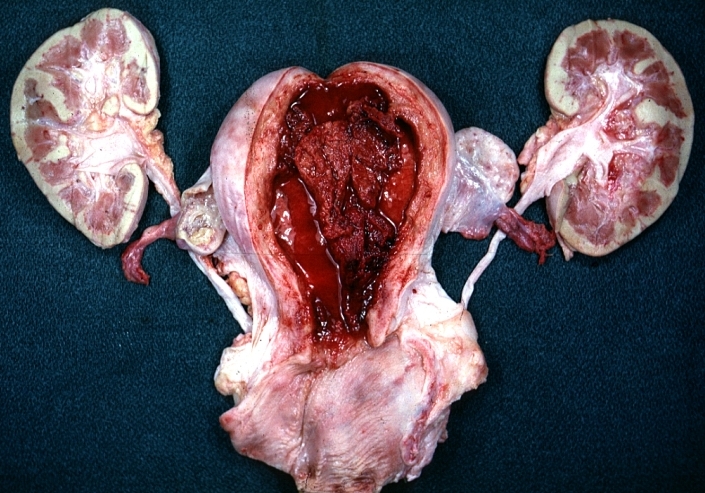Acute tubular necrosis: Difference between revisions
No edit summary |
(No difference)
|
Revision as of 14:16, 10 August 2011
| Acute tubular necrosis | |
 | |
|---|---|
| Acute Tubular Necrosis: Gross, good example of bilateral cortical necrosis and uterus with hemorrhage (secondary to abortion). Image courtesy of Professor Peter Anderson DVM PhD and published with permission © PEIR, University of Alabama at Birmingham, Department of Pathology | |
| ICD-10 | N17.0 |
| ICD-9 | 584.5 |
| DiseasesDB | 11263 |
| eMedicine | med/39 ped/28 |
| MeSH | D007683 |
|
Acute tubular necrosis |
|
Acute tubular necrosis On the Web |
|---|
|
Risk calculators and risk factors for Acute tubular necrosis |
Editor-In-Chief: C. Michael Gibson, M.S., M.D. [1]
Associate Editor-In-Chief: Cafer Zorkun, M.D., Ph.D. [2]
Please Join in Editing This Page and Apply to be an Editor-In-Chief for this topic: There can be one or more than one Editor-In-Chief. You may also apply to be an Associate Editor-In-Chief of one of the subtopics below. Please mail us [3] to indicate your interest in serving either as an Editor-In-Chief of the entire topic or as an Associate Editor-In-Chief for a subtopic. Please be sure to attach your CV and or biographical sketch.
Overview
Acute tubular necrosis or (ATN) is a medical condition involving the death of tubular cells that form the tubule that transports urine to the ureters while reabsorbing 99% of the water (and highly concentrating the salts and metabolic byproducts). Tubular cells continually replace themselves and if the cause of Acute Tubular Necrosis is removed then recovery is likely. ATN presents with acute renal failure and is one of the most common causes of ARF. The presence of "muddy brown casts" of epithelial cells found in the urine during urinalysis is pathognomonic for Acute Tubular Necrosis.
It may be classified as either toxic or ischemic. Toxic Acute Tubular Necrosis occurs when the tubular cells are exposed to a toxic substance (nephrotoxic Acute Tubular Necrosis). Ischemic Acute Tubular Necrosis occurs when the tubular cells do not get enough oxygen, a condition they are highly sensitive to due to their very high metabolism.
Toxic Acute Tubular Necrosis
Toxic ATN can be caused by free hemoglobin or myoglobin, by medication such as antibiotics and cytostatic drugs, or by intoxication (ethylene glycol, "anti-freeze").
Histopathology: Toxic ATN is characterized by proximal tubular epithelium necrosis (no nuclei, intense eosinophilic homogeneous cytoplasm, but preserved shape) due to a toxic substance (poisons, organic solvents, drugs, heavy metals). Necrotic cells fall into the tubule lumen, obliterating it, and determining acute renal failure. Basement membrane is intact, so the tubular epithelium regeneration is possible. Glomeruli are not affected.
Ischemic Acute Tubular Necrosis
Ischemic Acute Tubular Necrosis can be caused when the kidneys are not sufficiently perfused for a long period of time (i.e. renal artery stenosis) or during shock. Hypoperfusion can also be caused by embolism of the renal arteries. Ischemic Acute Tubular Necrosis specifically causes skip lesions through the tubules.
Pathology
Acute tubular necrosis from ethylene glycol
<youtube v=mqXx2EMTgec/>